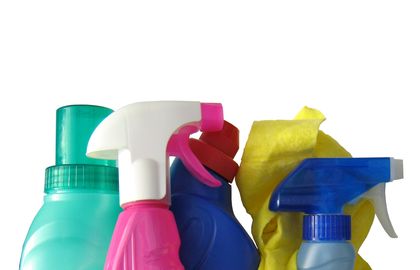Soaps and detergents

A detergent is a cleaning agent. Detergents can be classified into one of two general categories: natural soaps (or just soaps) and synthetic detergents (or syndets). Both soaps and syndets have many similarities, particularly with regard to their molecular structures and the way they clean objects.
The structure of soaps and detergents
Both soaps and syndets consist of very long molecules. A model of such molecules is shown below:
CH 3 CH 2 CH 2 CH 2 CH 2 CH 2 CH 2 CH 2 CH 2 CH 2 CH 2 CH 2 CH 2 CH 2 CH 2 CHCOO − , Na +
The characteristic of all such molecules is that they have very different ends. The left end of the above molecule is said to be hydrophobic, meaning it "hates water." That end of the molecule is attracted by fats and oils, but not by water. The right end of the molecule above is said to be hydrophilic, meaning it "loves water." That end of the molecule is attracted by water but not by fats and oils.
Most of the dirt that collects on clothing, dishes, and our bodies is surrounded by a thin layer of oil. Simply washing an object with water is not a very effective way of getting the object clean because oil and water do not mix with each other.
But suppose that a detergent, either a soap or a syndet, is added to the wash water. In that case, detergent molecules line up with one end attached to the oily dirt and the other end attached to water molecules. When the object is scrubbed or agitated, the oil-covered dirt attached to detergent molecules, which are also attached to water molecules, is removed from clothing, dishes, or human skin. The dirt-detergent-water combination can then disappear down the drain.
Soaps
No one knows exactly when soap was discovered. It was apparently used by the Phoenicians as early as the sixth century B.C. Modern methods of soapmaking were not perfected, however, until late in the eighteenth century. In 1790, French chemist Nicholas Leblanc (1742–1806) invented a process for making caustic soda (sodium hydroxide) from common table salt (sodium chloride). His invention made it possible to manufacture soap inexpensively from ordinary raw materials.
Soap is made by heating together fats or oils with water solutions of sodium hydroxide (lye). Molecules of fats and oils are very long molecules, like the one shown above. They do not have the charged group at the end of the molecule (—COO − , Na + ) as shown in that structure, however. The charged group is obtained from the sodium hydroxide with which the fat or oil is mixed.
Anyone can make his or her own soap simply by boiling a fat and lye together in a metal pot. The soap produced, however, would normally not be very pleasant to use. It would probably contain some left-over lye, which is very harsh. Washing with lye soap gets things clean but can be very damaging to human skin.
Today, soaps contain a number of ingredients to make them more pleasant to use. These ingredients include perfumes and coloring agents. Soaps may also be whipped into a lather when they are still liquid, to make them float; pressed into very hard bars, to make them last longer; or treated in other ways to give them special properties.
Synthetic detergents
Soap is one of the greatest chemical products ever invented by humans. It is highly effective in getting objects clean and in killing bacteria. But soap also has its disadvantages. Perhaps the most important of these disadvantages is its tendency to form precipitates in hard water.
Hard water gets its name because of the fact that it is hard to make suds when trying to use soap in it. Perhaps you have seen the grayish scum that forms in a bathtub or a wash basin after you've taken a bath or washed some clothes in well water. The scum is a precipitate formed when soap reacts with the chemicals that make water hard.
Washing with soap in hard water is a wasteful activity. The first thing that happens when you add soap to hard water is that the soap reacts with chemicals to form scum. In a way, you are just throwing away the first batch of soap you add because it can not be used to clean anything. Once all the chemicals in hard water are used up, then any additional soap can be used for cleaning something.
Syndets do not have this problem. When a syndet is added to hard water, no precipitate is formed. The syndet is ready to go to work immediately to start cleaning something.
The discovery of syndets in the 1940s had, therefore, a very dramatic effect on the soap market. In 1940, more than three billion pounds of soap were manufactured in the United States. Five years later, that number had risen to almost four billion pounds. In the same year, the first syndets began to appear on the market. After 1945, the amount of soap produced began to fall, while the amount of syndets began to increase. By 1970, about one billion pounds of soap was produced in the United States compared to nearly six billion pounds of syndets.
As with soaps, syndets are always a mixture of substances that includes more than the cleaning agent itself. These additives include brighteners, bleaching agents, fillers, "builders," and perfumes and coloring agents.
[ See also Alkali metals ]
a- Neutralization
b- Adding Builders
c- Adding Fillers
d- Temprature for all steps
e- Viscosity at all steps
f- Retion time required
Thanks.
Paras Dyes and Chemicals
Regards,
Karthikeyan.B
still,i have questions unanswered in my mind.